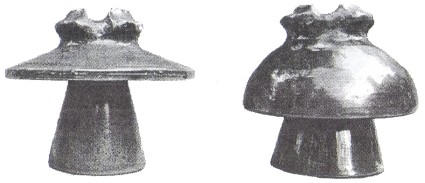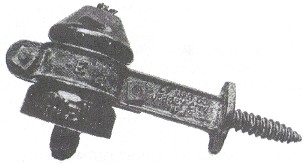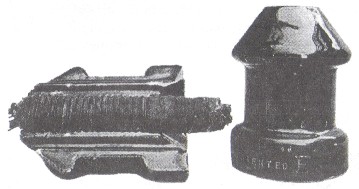Porcelain Insulator News
by Elton Gish
Reprinted from "Crown Jewels of the Wire", July 1998, page 9
Hopefully most of the mistakes I make in PIN are infrequent and
insignificant. This time my mistake was not minor but gratefully reported by
only one person, Howard Banks. Most of the readers of PIN either did not catch
the error, noticed but didn't bother to write, or were so confused you didn't
know what I was talking about. Howard became interested in Fred Locke insulators
after reading PIN in November 1997 CJ. He pointed out my error in that article
which confused the issue so badly that I probably should rewrite it. Please take
the time now to get your November 1997 issue and turn to page 10. Change all of
the mentions of M-2250 on page 10 to M-2430. Both styles are Fred Locke
insulators and extremely rare at that so most readers may not have caught the
difference. I started out on page 9 reporting the M-2250 Jeff Hogan obtained at
the 1996 London show which was correct (one M-2250 with #7-1 marking and two
unmarked M-2250's). M-2250 is the 2-part cemented version of U-964. The
insulators in the photo on page 10 are actually M-2430's. The whole M-2430 in
the picture has two #7-1 markings and it is the only known marked specimen.

M-2430 (left) and M-2250 (right).
Howard recently found pieces of M-2430 in Oregon which have the #6-2 and #7-1
Fred Locke marking, pieces of M-2795's with #4-1 marking, pieces of M-2842 with
#6-2 marking, and one piece of M-2842 with the #4-5 marking. All of the pieces
of Fred Locke insulators he found which show the manufacturing date bear various
dates from May to September 1901. When Howard first walked these old lines more
than 30 years ago, he didn't find any whole multipart porcelain insulators, and
he didn't bother to pick up the broken ones because he was looking for glass. We
will no doubt hear more about Howard's insulator hunts in the future.

Louis Fort "E" type insulator and metal bracket.

Louis Fort "E" type clamp insulator showing both halves
and section
of conductor with insulated covering. Note how
grooves formed in the inner
channel of the insulator left
impressions in conductor insulation when the
insulator
halves were clamped together.
Also in November 1997 CJ on page 13, PIN reported the Louis Fort clamp
insulator patented in 1917. Since then I acquired a nice example of the Louis
Fort clamp insulator complete with metal bracket and a piece of the insulated
conductor. Note that the "E" is in a different place on the insulator
(front and back) than the one reported in November, and the patent date appears
on only one side. The "E" is also on both sides of the metal bracket
and bears the 1917 patent date. The embossed (raised) marking on the dry process
porcelain insulator is as follows:
Front: PATENTED "E" 9/18/17
Back: PATENTED "E"
The embossed marking on the metal bracket is:
Front: L F MFG CO / JERSEY CITY / N.J.
Back: PAT 9-18-17 / AND / PATS PENDING
Note that the grooves formed along the inner channel of the insulator have
pressed into the conductor insulation, which allows the insulator to firmly grip
the conductor. The inner channel is not round but more of an elongated oval or
rectangle with round corners: 1/2" x 3/4".

Louis Fort "D" type clamp insulator.
Jeff Hogan has a Louis Fort "E" insulator like the one we reported
in November 1997 CJ and it even has a similar pretty glaze. Jeff also reported
having a "D" insulator complete with metal bracket marked with the
letter "D" (see photo) on both sides. Jeff notes that each half of the
insulator has a different glaze color, which may indicate the two halves, were not originally together. However, it would not surprise me that the
porcelain halves were shipped separate from the metal brackets (for large
orders) and assembled in the field. That would explain different glaze colors
and why both halves have the patent date. Note below that the quote marks around
each "D" are different. The embossed marking on the dry process
porcelain insulator is:
Front: "D" / PAT. SEPT. 18 1917
Back: 'D' (note single' mark) /
PAT. SEPT. 18 1917
The embossed marking on the metal bracket is:
Front: L F MFG CO / JERSEY CITY / N.J.
Back: PAT 9-18-17 / AND PATS / PENDING
Note the slightly different marking on the back side of the bracket and that
both halves of the insulator have the same marking except for the quote marks.
The inner channel on the "D" insulator is slightly larger: 3/4" x
1".
The "E" insulator (2-3/4" diameter by 3-3/4" tall) is
slightly smaller than the "D" (3" diameter by 3-7/8" tall).

Jeff Tracy and Wayne Erwin have searched many miles of railroad right-of-way
in the Missouri area looking for the MP marked U-152's. They have found quite a
few brown and white U-152' s with the incuse MP marking and their collection
exhibits the great variety of glaze and marking locations that can be found in
this particular insulator. They quickly noticed that, while many of the brown
U-152's were marked on either the skirt or the dome, all of the white ones were
marked on the dome. Then one day they found a white one marked on the skirt and
some time later they found a second skirt-marked one. Now each of them has a
skirt-marked white U-152. Jeff says the holder for the MP letters appears to be
different that that used to mark the other MP's. Both letters are placed
together with a more or less rectangular depression showing on one side. Of the
couple of hundred MP's they have seen, they have not seen any with the
rectangular impression showing on the dome-marked ones. I've been trying to
collect all the various marking locations and asked Jeff if they ever found
another one...... The skirt-marked ones were so rare that I did not seriously
think they would have much chance of finding another one.
This past March Jeff and Wayne decided to do more searching after work one afternoon and pick up a few of the original crossarms for a display for
their MP insulators. In the same vicinity where they found the other two
skirt-marked white U-152's, they found a third one about a half mile north!! The
insulator had popped off the crossarm and was hidden in thick undergrowth
undetected in their earlier searches. Jeff and Wayne are pretty excited about
this latest find and about making a new discovery their first year searching for
porcelain insulators. They are "having a ball hunting for them". You
should contact Jeff Tracy (ICON member) if you would like to get an MP marked
U-152. THANK YOU Jeff and Wayne for your gift of the third skirt-marked white
U-152 MP!!
| 